Intel Ghost Canyon NUC9i9QNX Review: NUC 9 Extreme Realizes the SFF Dream
by Ganesh T S on April 16, 2020 8:05 AM ESTGPU Performance for Workstations - SPECviewperf 13
The SPECviewperf benchmark from SPEC provides an idea of the capabilities of the GPU in a workstation from the perspective of different CAD, content creation, and visual data analysis tools. It makes more sense to process these benchmarks on workstations with professional GPUs, but, consumer GPUs are often the choice for machines that need to handle both gaming and professional workloads.
SPECviewperf 13 includes nine different workloads representative of graphics content and behavior of actual applications. They make use of the OpenGL 4.0 and DirectX 12 APIs under Windows. SPECviewperf 13's workloads (termed viewsets) can officially be run only at two desktop resolutions (1920 x 1080, and 3840 x 2160), and need the display scaling to be set to 100% (DPI of 96). The available viewsets are listed below.
- 3ds Max (3dsmax-06)
- CATIA (catia-05)
- Creo (creo-02)
- Energy (energy-02)
- Maya (maya-05)
- Medical (medical-02)
- Showcase (showcase-02)
- Siemens NX (snx-03)
- Solidworks (sw-04)
The 3ds Max and Showcase viewsets are available only when processing at 1920 x 1080. The rest are available at both resolutions.
We processed SPECviewperf 13 at both resolutions on the Intel NUC9i9QNX (Ghost Canyon). The benchmark measures the frame rate at which the GPU renders the scenes in a viewset. Each viewset is composed of different scenes and rendering modes, and the composite score for the viewset is a weighted geometric mean of the FPS measured for the different scenes. In this section, we take a look at how its composite scores stack up against other systems targeting this market segment.
3ds Max (3dsmax-06)
The 3dsmax-06 viewset comprises of 11 different scenes. They have been created from traces of the graphics workload generated by Autodesk 3ds Max 2016 using the default Nitrous DX11 driver. Additional details are available here.
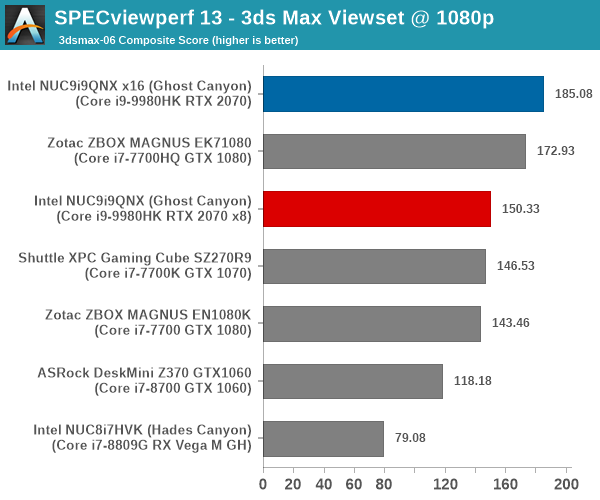
The x16 configuration for the RTX 2070 delivers significantly better results compared to the x8 configuration.
CATIA (catia-05)
The catia-05 viewset comprises of 14 different tests created from traces of the graphics workload generated by the CATIA V6 R2012 application from Dassault Systemes. Additional details are available here.
| SPECviewperf 13: CATIA Viewset Composite Scores | |||
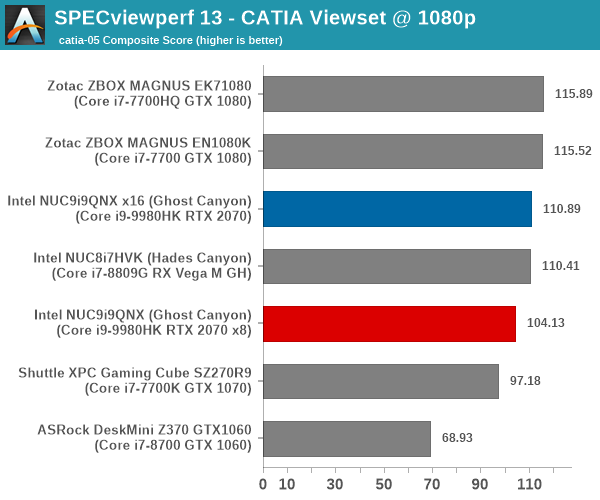
The RTX 2070 in the NUC9i9QNX doesn't emerge as a leader in this workload, but its performance is almost as good as the top candidate in the x16 configuration.
Creo (creo-02)
The creo-02 viewset comprises of 16 different tests created from traces of the graphics workload generated by the Creo 3 and Creo 4 applications from PTC. Additional details are available here.
| SPECviewperf 13: Creo Viewset Composite Scores | |||
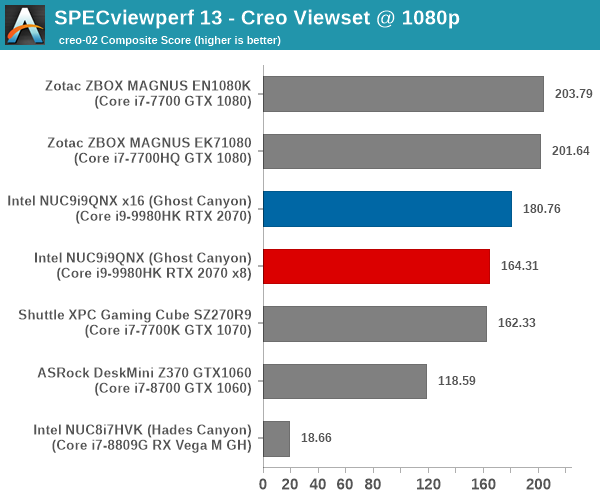
The significant difference between the x16 mode and x8 mode continues here, with the former putting the NUC9i9QNX within touching distance of the top performers.
Energy (energy-02)
The energy-02 viewset comprises of 6 different tests based on techniques used by the OpendTect seismic visualization application. Additional details are available here.
| SPECviewperf 13: Energy Viewset Composite Scores | |||

The NUC9i9QNX performs well in this workload, emerging as the top candidate. Strangely, the 1080p configuration seems limited by an unknown factor, with the x8 configuration performing better than the x16. At 4K, however, normal service is resumed.
Maya (maya-05)
The maya-05 viewset comprises of 10 different tests based on traces of the graphics workload generated by Autodesk Maya 2017. Additional details are available here.
| SPECviewperf 13: Maya Viewset Composite Scores | |||

The x16 configuration of the RTX 2070 emerges as the clear topper for the Maya workload.
Medical (medical-02)
The medical-02 viewset comprises of 8 different tests derived from 4 distinct datasets. Each test uses the ImageVis3D volume visualization program's Tuvok rendering core for 2D projections of 3D volumetric grids. Additional details are available here.
| SPECviewperf 13: Medical Viewset Composite Scores | |||

The NUC9i9QNX emerges second in this workload, next to the Core i7-7700HQ / GTX 1080 combination in the Zotac EK71080.
Showcase (showcase-02)
The showcase-02 viewset comprises of 4 tests created from traces of the Autodesk Showcase 2013 application rendering a racecar model with 8 million vertices using different modes. Additional details are available here.
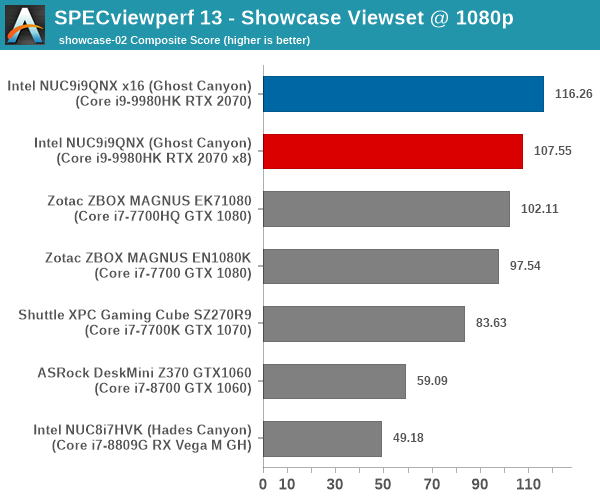
The x16 RTX 2070 configuration is the clear winner in this workload.
Siemens NX (snx-03)
The snx-03 viewset comprises of 10 tests created with traces from the graphics workload generated by the NX 8.0 application from Siemens PLM. Additional details are available here.
| SPECviewperf 13: Siemens NX Viewset Composite Scores | |||

The performance of various systems in this workload is poor (as evident from the SPECworkstation ratings for the corresponding workload). There is not much to separate the various configurations in this workload, as evident from the scores in the graphs above.
Solidworks (sw-04)
The sw-04 viewset comprises of 11 tests created from traces of Dassault Systemes’ SolidWorks 2013 SP1 application. Additional details are available here.
| SPECviewperf 13: Solidworks Viewset Composite Scores | |||
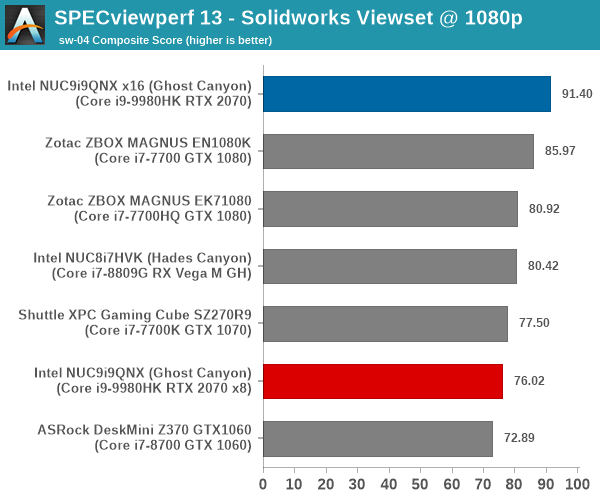
Overall, the RTX 2070 in the NUC9i9QNX delivers excellent performance for GPU-intensive workstation workloads. In all cases, the x16 mode provides much better performance compared to the original x8 configuration of our review sample.










109 Comments
View All Comments
buckiller - Thursday, April 16, 2020 - link
Power pig. Hades Canyon was great, but this is hot trash, relative to expectations set by last-gen and perf/power capabilities that are possible today.> The Ghost Canyon NUC9i9QNX is a SFF enthusiast's dream come true.
Ooph. Hardly.
Dolda2000 - Thursday, April 16, 2020 - link
I have to admit that I still don't really see the point of this system. It seems that its main gimmick is the fact that what is essentially the motherboard plugs into a PCIe riser card. That's fine and useful and all, but PCIe riser boards and cables are nothing new, and I don't really see what this does that hasn't already been doable for quite some time. You can replace the compute element? Sure, but being able to replace motherboards is nothing new to most form factors. Please do enlighten me if I'm missing something.Dragonstongue - Thursday, April 16, 2020 - link
the series adds the ability for end-users to add a standard PCIe video card to the system system.to the system's system ... or just to the system..
as for folks complain about the price, CPU alone is ~580 USD .. RTX 2070 mini ~539
so there is over $1k right there
I personally wouldn't be buying NUC "overall" based on should be Ryzen A and B absolutely not given seems Intel is "up to their same old BS tricks" via "preventing" folks from offering AMD based options available...
Destoya - Thursday, April 16, 2020 - link
$580 CPU, you have to be kidding. Nobody, including OEMs, pays the tray MSRP intel has listed.If you want to look at it in terms of value, it has the same performance as a Ryzen 3600 ($175)...
Deicidium369 - Thursday, April 16, 2020 - link
First off, there are no OEMs, it is single source Intel. I love Intel NUCs - not sure what the use case for this model is.Namisecond - Friday, April 17, 2020 - link
I don't think Intel manufactures those CPU cards (soldered BGA CPUs). They're probably integrated by a 3rd party OEM like Foxxcon. It's one thing to have engineering samples, but for Intel to step into the motherboard manufacturing game requires a lot of capital resources...unless the NUC parts are actually going to be made at Intel's engineering labs...If it's a production run in the 10Ks...that just might be feasible.Deicidium369 - Friday, April 17, 2020 - link
And like I said there are no OEMs available for you to buy from - single source - Intel. I thought I saw something a few years ago about possibly PNY - I know they do the Nvidia branded graphics cards.BlazingDragon - Thursday, April 16, 2020 - link
The article is misleading... and very Intel biased, IMHO.The ~$1500 USD price is for the i9 barebones kit only... just compute element [w/CPU], daughter board and PSU - i.e. not including a GPU, DRAM memory or SSD - that's why it's so outlandish...
Good ITX m/board & Ryzen 3900x CPU, plus really nice case and PSU is << $900 USD.
Deicidium369 - Thursday, April 16, 2020 - link
So a review of a product from Intel is very Intel biased.... That has to be a huge conspira-plotBlazingDragon - Thursday, April 16, 2020 - link
A review of anything can be positive or negative on that thing... and is unbiased if it seems balanced and fair in that criticism [be it positive or negative].If said article seems to over exaggerate the positives, and/or misrepresent them, and miss out or under call some of the negatives, then yes, it's biased... and IMHO, that's exactly what this article does...